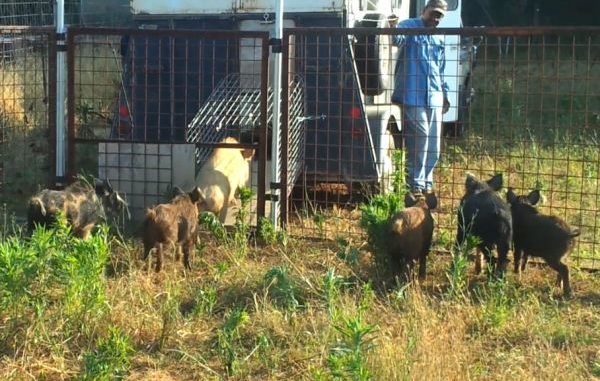
Fish-based formula containing sodium nitrite in early stages of development, researcher says
Researchers at LSU are currently developing a fish-based poison bait that, if ultimately approved by the Environmental Protection Agency and the U.S. Department of Agriculture, could put a serious dent into Louisiana’s wild hog population.
Dr. Glen Gentry, an associate professor with the LSU AgCenter based out of the IdleWild Research Station in Clinton, said the new bait would include sodium nitrite, which is potentially deadly to the estimated 500,000 feral pigs that call the Louisiana landscape home.
“It’s a component used in the food industry as a preservative in sausage and bacon to keep bacteria from growing in food,” Gentry said. “It turns out that pigs are more sensitive to its effects than people. That’s one of the things that makes it attractive as poison.”
The first goal of the project, which has been going on for about 18 months, was to determine the lethal dose of sodium nitrite for hogs, and Gentry said that’s already been accomplished.
“It’s 182 parts per million,” he said. “In pigs, sodium nitrite reduces the ability of the blood to carry oxygen. So basically what happens is the animal suffocates from the inside out. We looked at sex and we looked at weight because there’s tons of anecdotal evidence out there that says males may be less sensitive to females, or younger pigs may be more sensitive than older pigs.
“We didn’t see any of that in our studies.”
Gentry explained the multiple challenges of working with sodium nitrite: It readily breaks down in the environment, which is a good thing — but that also makes it harder to deliver a lethal dose to the hogs.
“It doesn’t bio-accumulate like some old pesticides did,” he said. “And there’s not a pyramid effect, where the target species would be killed, and then scavengers would come in and feed on the carcass and it would kills the scavengers, and then scavengers would scavenge on the scavengers — so you would have a center point and then all these other animals around that.
“We don’t think that’s going to be a problem with sodium nitrite because it breaks down so readily.”
But the chemical, which resembles table salt in appearnce, is also bitter — yet another obstacle the researchers have to overcome.
“We wanted to come up with a bait that would be more palatable and also protect the nitrite, so we’re working with a semi-solid bait. It’s not a grain-based bait,” Gentry said. “It’s a semi-solid bait with corn meal, but we’re in the middle of running preference trials.”
Since whole kernel corn is so popular for use in traps, Gentry said researchers wanted the poison to be preferred by hogs over corn. They tried maple syrup, strawberry and marshmallow flavorings, among others, but the pigs seemed to prefer a fish-based bait, so work is ongoing now to develop a formula using dehydrated pogeys.
“I think it’s probably scent-based, and pigs are after calories. That’s what they’re looking for. So when we dehydrated the fish, we concentrated the energy in there… We have to get to the point where we can kill 90 percent of the pigs that we deliver the bait to, and we’re not there yet,” he said. “We know what it takes to kill the pigs, but we have to figure out how to get it in them and how to protect the nitrite from the environmental conditions that we have.
“I think what’s happening is in the bait formulation there’s some step that is reducing the amount of sodium nitrite in that bait. It’s transforming it into something else — it’s breaking it down.”
Gentry envisions the poison being dispensed via a feeder with a sim card that would text an off-site operator a picture of an approaching animal when motion was detected. When it was confirmed that hogs were at the site, the operator would then activate release of the poison bait.
“Think of it like a gum ball machine,” he said. “You would text it and it would release X number of baits. If you need more and had X number of pigs, you would text it again and it would release X amount of bait.”
As part of the project, researchers must also determine the susceptibility of non-target animals — like raccoons, possums, crows, deer, buzzards, Louisiana black bears and coyotes — to sodium nitrite in the fish-based bait.
The plan is for hogs that die from the poison to decompose — or be eaten — on the landscape.
“We did find that raccoons love them, which we kind of figured they would. Crows loved them, which we didn’t figure. We did put some blank pogey baits without the poison in deer feed with the captive whitetail herd up here, and they did did not eat the pogey fish, which is a good thing,” he said. “We’re assuming possums would eat them and bears would eat them.
“When I give my talks, I tell people if we kill a Louisiana black bear, this is over. We can’t afford to do that.”
Researchers are also accounting for potential human consumption of the sodium nitrite in a hog that gets killed by a hunter.
“The FDA says food for human consumption can have up to 200 parts per million sodium nitrite, so the lethal dose for the pig is lower than what the FDA says we can have in a finished meat product for human consumption,” he said. “If a pig comes in and gets a sub-lethal dose and walks off, and a hunter sees the pig and shoots the pig, then the meat should be fit for consumption because the nitrite breaks down so readily.”
There is currently no timetable for completion of the project or potential approval by the necessary government agencies, but Gentry was confident researchers would ultimately come up with a formula that is lethal to pigs and safe for non-target animals.
“The problem is too great for all this just to disappear,” he said.


